Related Research Articles
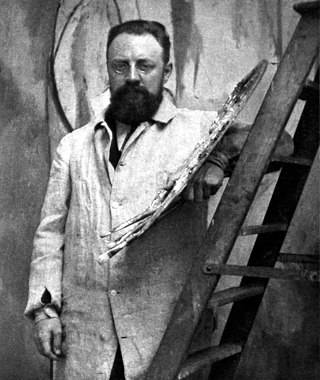
Henri Émile Benoît Matisse was a French visual artist, known for both his use of colour and his fluid and original draughtsmanship. He was a draughtsman, printmaker, and sculptor, but is known primarily as a painter. Matisse is commonly regarded, along with Pablo Picasso, as one of the artists who best helped to define the revolutionary developments in the visual arts throughout the opening decades of the twentieth century, responsible for significant developments in painting and sculpture.
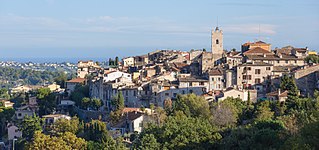
Vence is a commune set in the hills of the Alpes-Maritimes department in the Provence-Alpes-Côte d'Azur region in Southeastern France, north of Nice and Antibes on the Mediterranean coast.
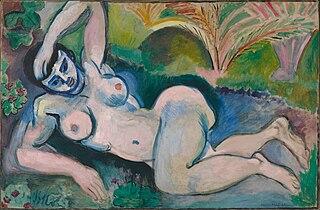
Blue Nude (Souvenir of Biskra) (French: "Nu bleu, Souvenir de Biskra"), an early 1907 oil painting on canvas by Henri Matisse, is located at the Baltimore Museum of Art as part of the Cone Collection.

Paul Rosenberg was a French art dealer. He represented Pablo Picasso, Georges Braque and Henri Matisse. Both Paul and his brother Léonce Rosenberg were among the world's major dealers of modern art.
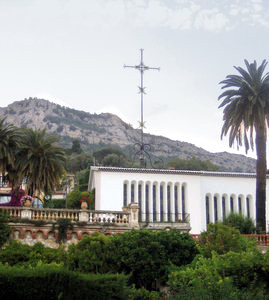
The Chapelle du Rosaire de Vence, often referred to as the Matisse Chapel or the Vence Chapel, is a small Catholic chapel located in the town of Vence on the French Riviera. It was dedicated to the Dominican Order. The church was built and decorated between 1947 and 1951 under a plan devised by artist Henri Matisse.

The Blue Nudes is a series of collages, and related color lithographs, by Henri Matisse, made from paper cut-outs depicting nude figures in various positions. Restricted by his physical condition after his surgery for stomach cancer, Matisse began creating art by cutting and painting sheets of paper by hand; these Matisse viewed as independent artworks in their own right. The Blue Nudes refers also to the editioned multiples based on the cut-outs. Matisse supervised the creation of these lithographs until his death in 1954.

The Painter and His Model is a work by Henri Matisse painted late 1916, early 1917. It is currently in the collection of the Musée National d'Art Moderne, Centre Georges Pompidou, Paris. In this work Matisse depicted himself in his studio on the fourth floor of 19 Quai Saint-Michel, at work on his painting Laurette in a Green Robe (1916).

Zorah on the Terrace is an oil on canvas painting by French painter Henri Matisse, created in 1912. It is in the collection of the Pushkin Museum of Fine Arts, Moscow, Russia.
Purple Robe and Anemones is a 1937 painting by Henri Matisse featuring a woman wearing a purple robe sitting next to a vase of anemones.

Asia is a painting by Henri Matisse. It is an oil on canvas painting from 1946.
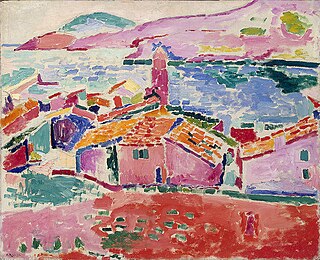
View of Collioure is a 1905 oil-on-canvas painting by Henri Matisse. It is an example of the style that Matisse employed during his early period of Fauvism. The painting has been in the collection of The Hermitage, St. Petersburg, Russia since 1948. It was originally part of the Sergei Shchukin collection, and then was at the State Museum of New Western Art in Moscow.

Window at Tangier; also referred to as La Fenêtre à Tanger, Paysage vu d'une fenêtre, and Landscape viewed from a window, Tangiers, is a painting by Henri Matisse, executed in 1912. It is held at the Pushkin Museum of Fine Arts, Moscow.

The Matisse Museum is a museum in Le Cateau-Cambrésis, France that primarily displays paintings by Henri Matisse. The museum was established by Matisse himself on 8 November 1952; he also defined the way his works should be arranged. At that time the museum was located in the wedding room of the Le Cateau City Hall.

Musée d'Art Moderne de Paris or MAM Paris, is a major municipal museum dedicated to modern and contemporary art of the 20th and 21st centuries, including monumental murals by Raoul Dufy, Gaston Suisse, and Henri Matisse. It is located at 11, Avenue du Président Wilson in the 16th arrondissement of Paris.
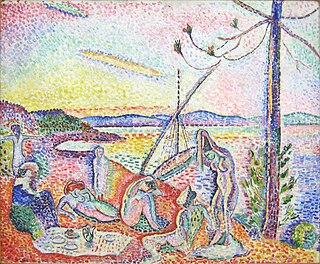
Luxe, Calme et Volupté is a 1904 oil painting by the French artist Henri Matisse. Both foundational in the oeuvre of Matisse and a pivotal work in the history of art, Luxe, Calme et Volupté is considered the starting point of Fauvism. This painting is a dynamic and vibrant work created early on in his career as a painter. It displays an evolution of the Neo-Impressionist style mixed with a new conceptual meaning based in fantasy and leisure that had not been seen in works before.

Fauvism is a style of painting and an art movement that emerged in France at the beginning of the 20th century. It was the style of les Fauves, a group of modern artists whose works emphasized painterly qualities and strong colour over the representational or realistic values retained by Impressionism. While Fauvism as a style began around 1904 and continued beyond 1910, the movement as such lasted only a few years, 1905–1908, and had three exhibitions. The leaders of the movement were André Derain and Henri Matisse.
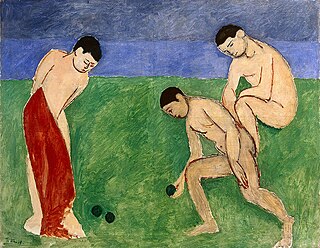
Game of Bowls is a 1908 painting by the French artist Henri Matisse. The painting shows three young men, probably Matisse's sons and nephew, playing a game of boules. Matisse sees the game as a manifestation of man's creativity, and an instrument to use in understanding the codes of life. The painting is part of Matisse's series on man's "Golden Age" and was part of Sergei Shchukin's collection before the October Revolution of 1917. It is now in the collection of The Hermitage, St. Petersburg, Russia.
Lydia Nikolaevna Délectorskaya was a Russian refugee and model best known for her collaboration with Henri Matisse from 1932 onwards.
Hanne Finsen was a Danish art historian and museum director who had a special interest in French art. While at the National Gallery of Denmark, in 1970 she arranged the internationally acclaimed Henri Matisse retrospective. In 1978, she was appointed director of both the Hirschsprung Collection and the Ordrupgaard Collection. At Ordrupgaard, she presented a number of exhibitions, including those on Vilhelm Hammershoi and Édouard Manet. In 2005, in collaboration with the Musée du Luxembourg, Finsen presented "Matisse – A Second Life" at the Louisiana Museum of Modern Art, an exhibition focusing on the painter's later works.
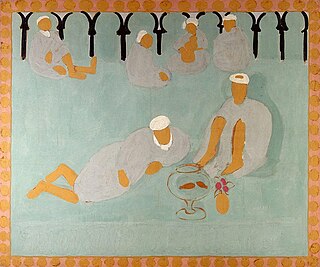
Arab Coffeehouse, is an oil-on-canvas painting by French visual artist Henri Matisse. Produced in 1913, Arab Coffeehouse was part of a series of goldfish paintings that Matisse produced in the 1910s and 1920s.
References
- ↑ Museum collection
- ↑ Christophe Viart, Matisse déculotté par la caméra, Henri Matisse de François Campau, Presses universitaires de Rennes, 2008, pp. 185-194 (French)